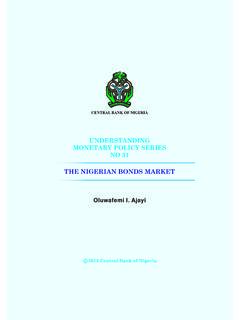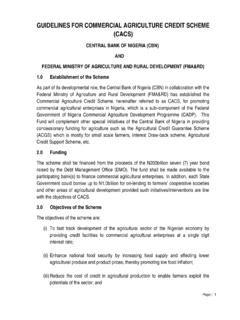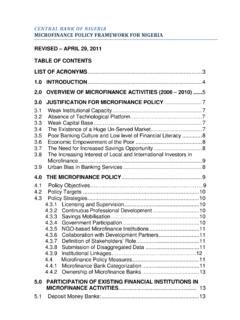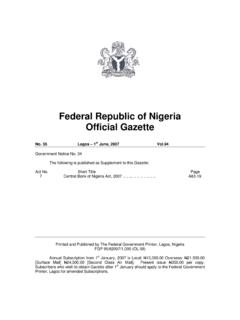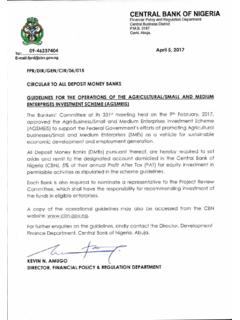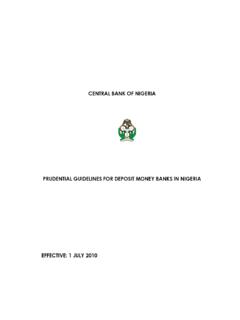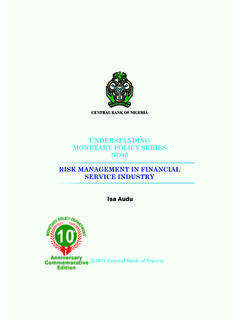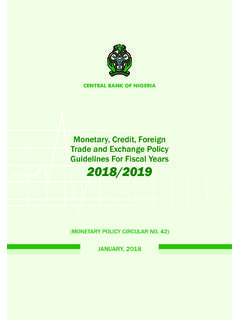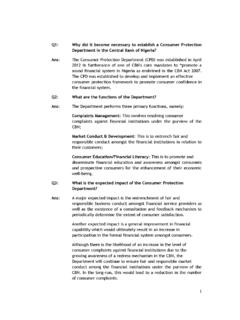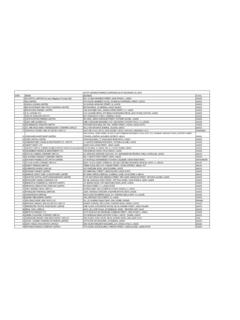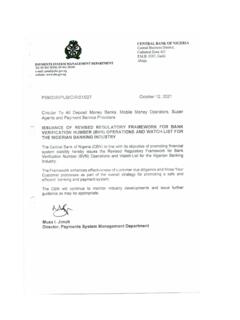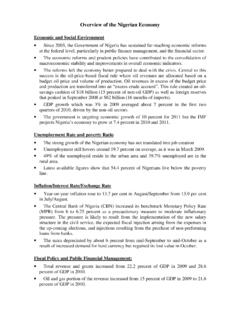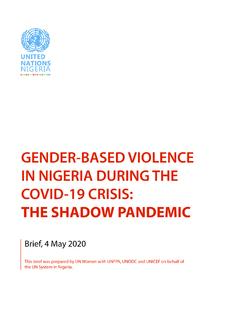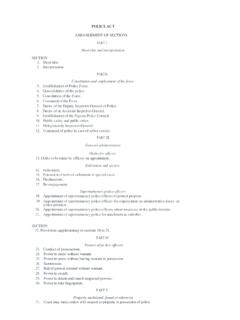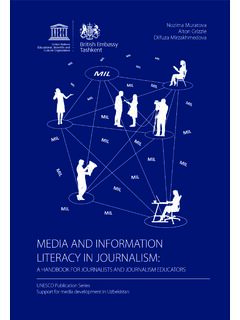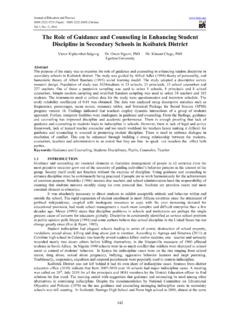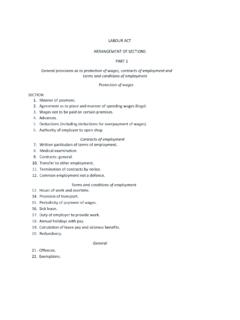Transcription of NIGERIAN PAYMENTS SYSTEM - Central Bank of Nigeria
1 Central BANK OF Nigeria NIGERIAN PAYMENTS SYSTEM RISK AND INFORMATION SECURITY MANAGEMENT FRAMEWORK NIGERIAN PAYMENTS SYSTEM RISK AND INFORMATION SECURITY MANAGEMENT FRAMEWORK TABLE OF CONTENTS 1. INTRODUCTION .. 1 2. OBJECTIVES OF THE FRAMEWORK .. 2 3. SCOPE .. 2 4. RISK MANAGEMENT GOVERNANCE STRUCTURE .. 3 5. ROLES AND RESPONSIBILITIES .. 3 Central BANK OF Nigeria (CBN) .. 3 PAYMENT INITIATIVE COORDINATING COMMITTEE (PICC) .. 4 PAYMENTS SCHEME BOARD (PSB) .. 4 6. RISKS IN PAYMENTS SYSTEM .. 4 SYSTEMIC RISK .. 4 CREDIT RISK .. 4 LIQUIDITY RISK: .. 5 OPERATIONAL RISK .. 5 COMPLIANCE, LEGAL AND REGULATORY RISK .. 5 SETTLEMENT RISK .. 5 INFORMATION SECURITY RISK .. 5 7. GENERAL POLICY EXPECTATIONS .. 5 PRINCIPLES FOR FINANCIAL MARKET INFRASTRUCTURES .. 5 RISK MANAGEMENT FRAMEWORK .. 6 8. OTHER CONSIDERATIONS FOR A RISK MANAGEMENT FRAMEWORK .. 9 LEGAL AND REGULATORY .. 9 NIGERIAN PAYMENTS SYSTEM RISK AND INFORMATION SECURITY MANAGEMENT FRAMEWORK BUSINESS CONTINUITY.
2 10 KNOW YOUR CUSTOMER / CLIENT (KYC) .. 10 SCHEME OPERATIONS .. 11 SETTLEMENT RULES AND DEFAULT MANAGEMENT .. 11 INFORMATION SECURITY .. 12 OTHER REQUIREMENTS .. 12 9. SCHEME SPECIFIC REQUIREMENTS .. 13 CARD PAYMENT SCHEME RISK REQUIREMENTS .. 13 RTGS PAYMENT SCHEME RISK REQUIREMENTS .. 13 ACH, CHEQUE AND INSTANT PAYMENT SCHEME RISK REQUIREMENTS .. 14 MOBILE PAYMENT SCHEME RISK REQUIREMENTS .. 14 10. DISPUTE RESOLUTION .. 15 11. RISK MONITORING .. 16 12. RISK REPORTING .. 16 13. CBN OVERSIGHT .. 17 NIGERIAN PAYMENTS SYSTEM RISK AND INFORMATION SECURITY MANAGEMENT FRAMEWORK 1 | P a g e 1. INTRODUCTION The journey to the PAYMENTS SYSTEM Vision 2020 (PSV 2020) started in 2007 with the objective of making the Nigeria PAYMENTS SYSTEM internationally recognised and nationally utilised. The phased implementation of the vision and other developments in the financial space including the pursuit of the Financial SYSTEM Stability Vision 2020(FSS 2020) has stimulated an exponential growth in financial activities and hence in the volume and value of payment flows both within and across national borders.
3 The rapid growth in the volume and value of financial transactions represents an important source of revenue for the providers of payment services particularly banks and other stakeholders. Other benefits include: fostering safety and efficiency of payment, clearing, settlement, and recording systems, promotion of financial SYSTEM stability, speed of service and transactions, development of new lifestyle products, financial inclusion, etc. The growth has also significantly altered the risks associated with the payment and settlement of these transactions. As a result, payment and settlement systems are important potential sources of systemic risks. Furthermore, PAYMENTS SYSTEM may increase, shift, concentrate, or otherwise transform risks in unanticipated ways. The failure of one or more of the participants in a payment SYSTEM to settle their PAYMENTS or other financial transactions as expected, in turn, could create credit or liquidity problems for participants and their customers, the SYSTEM operator, other financial institutions, and the financial markets the payment SYSTEM serves.
4 Such a failure may ultimately undermine public confidence in the nation s financial SYSTEM . It is therefore necessary to effectively manage the risks associated with PAYMENTS SYSTEM , as such systems which inherently create interdependencies among financial institutions can create systemic risks. A disruption may originate from any of the interdependent entities, including the SYSTEM operator, participants in a payment SYSTEM , or other systems, and spread quickly and widely across markets if the risks that arise among these parties are not adequately measured, monitored, and managed. For example, interdependencies are usually based on a series of complex and time sensitive transactions and payment flows which, in combination with a payment SYSTEM s design, can lead to significant demands for intraday credit or liquidity, on either a regular or an extraordinary basis. The Central Bank of Nigeria (CBN) as a settlement institution plays an important role in the PAYMENTS SYSTEM .
5 It is the primary provider of intraday balances and credit to foster the smooth operation and timely completion of settlement processes. To that extent, the CBN may face the risk of loss if such intraday credit is not repaid as planned. NIGERIAN PAYMENTS SYSTEM RISK AND INFORMATION SECURITY MANAGEMENT FRAMEWORK 2 | P a g e Furthermore, mitigating the risks associated with PAYMENTS SYSTEM is important for the effective management of monetary policy and banking supervision. For example, the orderly settlement of Open Market Operations (OMO) and the efficient movement of funds throughout the financial SYSTEM via the financial markets and the PAYMENTS SYSTEM that support those markets are critical to the effective implementation of monetary policy. Similarly, supervisory objectives must take into account the risks that payment systems pose to the financial SYSTEM by participating directly or indirectly in, or providing settlement, custody, or credit services.
6 In the interconnected environment, the safety and efficiency of these systems may affect the stability and soundness of financial institutions and consequently the financial stability of the country. As a result, safeguarding the integrity of the PAYMENTS SYSTEM in Nigeria has acquired additional significance and calls for the upgrading of associated risk management procedures through concerted efforts by market participants and the relevant authorities, notably the CBN. In light of the above, the CBN approved the NIGERIAN PAYMENTS SYSTEM Risk and Information Security Management Framework (this Framework) to guide the management of risks associated with the PAYMENTS SYSTEM in Nigeria . 2. OBJECTIVES OF THE FRAMEWORK The objectives of this framework include to: a. identify and address sources of systemic risks within the NIGERIAN PAYMENTS SYSTEM landscape; b. establish sound governance arrangements to oversee the risk management framework by ensuring that risks are identified, monitored and treated; c.
7 Establish clear and appropriate rules and procedures to carry out the risk-management objectives; d. employ the resources necessary to achieve the PAYMENTS SYSTEM s risk management objectives; and e. integrate risk management into the decision making processes of the Scheme Boards and Working Groups under PSV 2020. 3. SCOPE This Framework is designed to guide the operators and users of the payment systems across Nigeria . These systems may be organized, located, or operated within Nigeria (domestic PAYMENTS ), outside Nigeria (offshore PAYMENTS ), or both (cross-border PAYMENTS ) and may involve currencies other than the Naira (non- NIGERIAN PAYMENTS SYSTEM RISK AND INFORMATION SECURITY MANAGEMENT FRAMEWORK 3 | P a g e Naira systems and multi-currency systems). The scope of the Framework also includes any payment SYSTEM based or operated in Nigeria that engages in the settlement of non-Naira transactions operating within Nigeria and those that operate across the NIGERIAN borders (cross border payment systems); along with their infrastructure providers and the Payment Service Providers (PSPs) that make up these systems.
8 This Framework does not apply to arrangements for the physical movement of cash or systems for settling securities nor apply to market infrastructures such as trading exchanges, trade-execution facilities, or multilateral trade-compression systems. It is also not intended to apply to bilateral payment, clearing, or settlement relationships, where a payment SYSTEM is not involved, between financial institutions and their customers, such as traditional correspondent banking and government securities clearing services. 4. RISK MANAGEMENT GOVERNANCE STRUCTURE The PAYMENTS SYSTEM Management Department of the CBN is responsible for setting, applying and coordinating risk standards across the Nigeria PAYMENTS space. It is supported by the PAYMENTS Initiative Coordinating Committee and the four (4) Scheme Boards. 5. ROLES AND RESPONSIBILITIES Central BANK OF Nigeria (CBN) The overall responsibility for the management of risk across the National PAYMENTS SYSTEM rests with the CBN.
9 The CBN is expected to drive the overall National PAYMENTS SYSTEM Strategy, provide cross-scheme resource and arbitrate in cross-scheme decisions. Its risk governance responsibilities include to: a. provide risk oversight of the PAYMENTS SYSTEM and ensure adequate resources are allocated to risk management activities; b. approve the risk strategy for the PAYMENTS SYSTEM ; c. set risk parameters and tolerances within which payment SYSTEM activities would be conducted; d. determine and periodically review PAYMENTS SYSTEM key policies and processes; and e. review PAYMENTS SYSTEM risk reports and direct remedial and / or mitigating actions as appropriate. NIGERIAN PAYMENTS SYSTEM RISK AND INFORMATION SECURITY MANAGEMENT FRAMEWORK 4 | P a g e PAYMENT INITIATIVE COORDINATING COMMITTEE (PICC) The membership of PICC is composed of all the Chairpersons of the Payment Scheme Boards, PAYMENTS Initiative Working Groups, Special Interest Working Groups and Independent Director(s) representing the end-user community.
10 The PICC is Chaired by the Director, PAYMENTS SYSTEM Management Department The PICC provides advisory services to the Bank on PAYMENTS SYSTEM . It also serves as a forum where issues relating to risk affecting the various initiatives are discussed. PAYMENTS SCHEME BOARD (PSB) The PSBs are responsible for monitoring full conformance to the Principles of Financial Market Infrastructure and other best practices. The PSBs shall recommend initiatives, strategies and policies to the CBN with a view to close any gaps related to full conformance to agreed best practice. This ensures the resiliency and efficiency of the NIGERIAN PAYMENTS SYSTEM . Also, the PSBs provide advise to the CBN for the establishment of an appropriate general Risk Management Framework for their respective scheme. 6. RISKS IN PAYMENTS SYSTEM The basic risks in PAYMENTS SYSTEM include systemic risk, credit risk, liquidity risk, operational risk, legal risk, settlement risk and information security risk.
